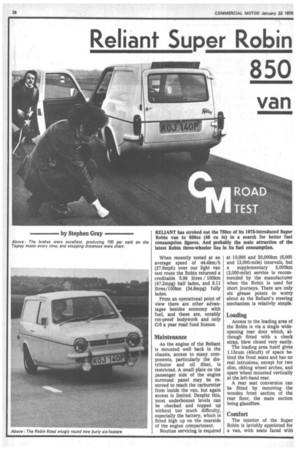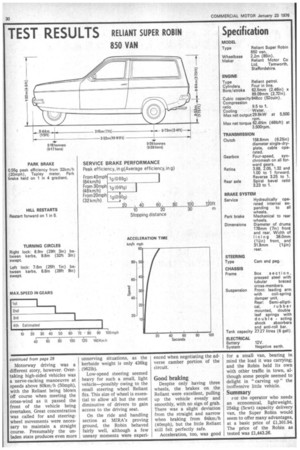Reliant Super Robin 850 van
Page 30

Page 31

Page 32

If you've noticed an error in this article please click here to report it so we can fix it.
When recently tested at an average speed of 44.4km/h (27.6mph) over our light van test route the Robin returned a creditable 5.98 litres / 100km (47.2mpg) half laden, and 8.11 Iitres/100km (34.8mpg) fully laden.
From an operational point of view there are other advantages besides economy with fuel, and these are, notably rot-proof bodywork and only £16 a year road fund licence.
Maintenance
As the engine of the Reliant is mounted well back in the chassis, access to many components, particularly the distributor and oil filter, is restricted. A small plate on the passenger side of the engine surround panel may be removed to reach the carburetter from inside the van, but again access is limited. Despite this, most underbonnet levels can be checked and topped up without too much difficulty, especially the battery, which is fitted high up on the nearside of the engine compartment.
Routine servicing is required at 10,000 and 20,000km (6,000 and 12,000-mile) intervals, but a supplementary 5,000km (3,000-mile) service is recommended by the manufacturer when the Robin is used for short journeys. There are only six grease points to worry about as the Reliant's steering mechanism is relativly simple.
Loading
Access to the loading area of the Robin is via a single wideopening rear door which, although fitted with a check strap, blew closed very easily.
The loading area itself gives 1.13cum (40cuft) of space behind the front seats and has no real intrusions, except for two slim, oblong wheel arches, and spare wheel mounted vertically at the left-hand rear.
A rear seat conversion can be fitted by removing the wooden front section of the rear floor, the main section being glassfibre.
Comfort
The interior of the Super Robin is lavishly appointed for a van, with seats faced with brushed nylon, and wall to wall carpeting. But driver and passenger space is limited by a large central lump covering the engine and the gearbox bell-housing.
All the instruments can be easily seen by the driver, despite the small, three-spoke steering wheel. Switches and mirror controls, such as the screen washer button, are situated directly in front of the driver next to the speedometer and the combined fuel and water gauges. The manual choke and heater temperature controls are mounted on a central console, which is extended to surround the short gear lever.
Although the ignition/starter switch is fitted in a nacelle around the steering column, it does not lock the column when the key is removed. Flashers, horn and headlamp dipper are combined in the familiar multifunction switch also fitted on the steering column.
The Super Robin van is supplied with hazard warning lights, two exterior mirrors and two auxiliary lamps as standard, but a heated rear window is an optional extra.
Motorway travel
The Robin was delivered for test with a 250kg (550Ib) load of sandbags, pushed well towards the front of the van. In this condition town driving was quite acceptable—in fact, it almost felt as though the van had four wheels.
Motorway driving was a different story, however. Overtaking high-sided vehicles was a nerve-racking manoeuvre at speeds above 80km/h (50mph), with the Reliant being blown off course when meeting the cross-wind as it passed the front of the vehicle being overtaken, Great concentration was called for and steeringwheel movements were necessary to maintain a straight course. Presumably the unladen state produces even more unnerving situations, as the kerbside weight is only 436kg (9621b).
Low-speed steering seemed heavy for such a small, light vehicle—possibly owing to the small steering wheel Reliant fits. This size of wheel is essential to allow all but the most diminutive of drivers to gain access to the driving seat.
On the ride and handling section at MIRA's proving ground, the Robin behaved fairly well, although a few uneasy moments were experi enced when negotiating the adverse camber portion of the circuit.
Good braking
Despite only having three wheels, the brakes on the Reliant were excellent, pulling up the vehicle evenly and smoothly, with no sign of grab. There was a slight deviation from the straight and narrow when braking from 64km/h (40mph), but the little Reliant still felt perfectly safe.
Acceleration, too, was good for a small van, bearing in mind the load it was carrying; and the Robin held its own with other traffic in town, although some people seemed to delight in " carving up" the inoffensive little vehicle.
Summary
r or the operator who needs an economical, lightweight, 254kg (5cwt) capacity delivery van, the Super Robin would seem to offer many advantages, at a basic price of £1,301.94. The price of the Robin as tested was £1,443,26.
















































































